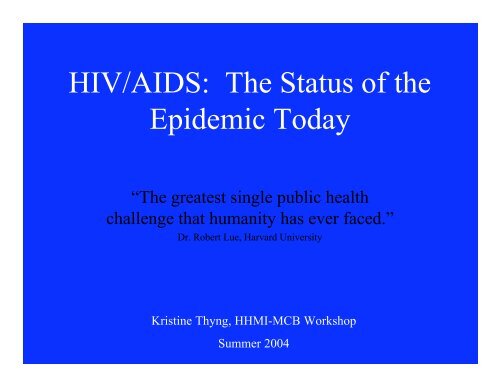HIV/AIDS - Life Sciences Outreach Program - Harvard University
HIV/AIDS - Life Sciences Outreach Program - Harvard University
HIV/AIDS - Life Sciences Outreach Program - Harvard University
- No tags were found...
Create successful ePaper yourself
Turn your PDF publications into a flip-book with our unique Google optimized e-Paper software.
<strong>HIV</strong>/<strong>AIDS</strong>: The Status of theEpidemic Today“The greatest single public healthchallenge that humanity has ever faced.”Dr. Robert Lue, <strong>Harvard</strong> <strong>University</strong>Kristine Thyng, HHMI-MCB WorkshopSummer 2004
Worldwide• 3 million deaths in 2003• Over 21 million deaths since thebeginning of the epidemic• 17.5 million adults• 4.3 million children (under 15years old)Image fromhttp://www.freegraphics.com/images/downloads/worldaids/index3.html(www.avert.org/worldstats.htm)
Worldwide cont’d• Approximately 40 million people living with<strong>AIDS</strong> worldwide in 2003• Approximately 14 million children orphaned by<strong>AIDS</strong> by the end of 2002• Number of orphans expected to rise to 25 millionby 2010(www.avert.org)
Adult Prevalence of <strong>AIDS</strong>Image from http://www.hivaidssearch.com/hiv-aids-links.asp?id=811
People With <strong>HIV</strong>/<strong>AIDS</strong>, by RegionEnd 2002Sub-SaharanAfrica71%Latin America4%South andSoutheast Asia14%Caribbean1% North Africaand MiddleEast1%WesternEurope1%East Asia andthe Pacific3%North America2%EasternEurope/CentralAsia3%Australia andNew Zealand
United States• By the end of 2002: 384, 906 people living with<strong>AIDS</strong>– 46% White– 34% Black– 18% Hispanic– 298,248 men– 82,764 women(www.avert.org/statsum.htm)
United States Cont’d• Of the 298, 248 U.S. men living with <strong>AIDS</strong>,• 57% were men who had sex with men (MSM)• 23% were I.V. drug users• 10% were exposed through heterosexual contact• 8% were both MSM and IV(www.avert.org/statsum/htm)
United States Cont’d• Of the 82,764 U.S. women living with <strong>AIDS</strong>,• 61% were exposed through heterosexual contact• 36% were I.V. drug users(www.avert.org/statsum/htm)
Image from http://www.cdc.gov/hiv/graphics/images/l178/l178-3.htm
United States Cont’d1999: Estimated that 800,000 to 900,000Americans were infected with <strong>HIV</strong>(www.avert.org/statsum/htm)
Image from http://www.hivaidssearch.com/hiv-aids-links.asp?id=936
How A Healthy Immune SystemWorks• Physical Barriers: skin, mucus, etc.• Innate Immune System: body’s immediateresponse to a pathogen. Not antigen specific.Immunity a person is born with.• Acquired Immune System: Body takes a fewdays to build this immunity. Antigen specific.Immunity that is acquired through life.
Key Structures of theImmune SystemImage from http://health.allrefer.com/pictures-images/immunesystem-structures-1.html
Physical BarriersSkinimage fromhttp://health.allrefer.com/picturesimages/skin-layers.htmlMucosaimage fromhttp://www.health.allrefer.com/health/mucosa-info.html
Innate ImmunityIf pathogenspenetrate physicalbarriers,phagocytic cellsin the area beginto engulfpathogen.Image from http://health.yahoo.com/health/ency/adam/000821/i9478
Innate Immunity Cont’d• Phagocytes also release chemical signals (cytokines) to“call” other phagocytes to the area, resulting ininflammation (redness, heat, swelling). The pus that weoften observe is a combination of dead pathogen, whiteblood cells, and injured body cells.Image fromhttp://occawlonline.pearsoned.com/bookbind/pubbooks/campbell6e_awl/chapter43/deluxe.html
Acquired Immunity• If pathogens are not completely eliminated by the innateimmune system, the acquired immune system is activated.• Key Players: Lymphocytes (T and B cells)Image fromhttp://occawlonline.pearsoned.com/bookbind/pubbooks/campbell6e_awl/chapter43/deluxe.html
Acquired Immunity Cont’d•Phagocytes active in the innateimmune system display some ofthe proteins from the pathogen ontheir surfaces, “advertising” thatthe pathogen is present.Macrophage (yellow) attackingbacteria (blue)Image from http://www.rit.edu/~photo/IFS/index-pages/IFS-37.html• These cells then travel to thelymph nodes and spleen, wherethey help to activate T and B cells.The increase in T and B cellproduction when you are ill canoften be detected by swollenlymph nodes (glands).
Acquired Immunity Cont’dB cells – Defend againstpathogens located outsideof body’s cells. *• Plasma cells – produceantibodies which attach toantigens and help todestroy them, or block theharmful effects of theantigen• Memory cells – Can reactquickly to produceantibodies upon additionalexposures to the antigenImage from http://www.accessexcellence.org/AB/GG/Antibody.html*Dr. Starnbach lecture 7/13/04
Acquired Immunity Cont’d• T cells – Defend againstpathogens located inside ofbody’s cells.*– Helper T cells: secretecytokines to call in other T,B, and phagocytic cells,activate B cells to produceantibodiesT cell (SEM)– Killer T cells: recognize aninfected cell and lyse it– Memory T cells: remain inbody to react when pathogenis encountered again.Image from http://ca.encarta.msn.com/media_461519550/Lymphocyte.html*Dr. Starnbach lecture 7/13/04
How it all works togetherImage fromhttp://occawlonline.pearsoned.com/bookbind/pubbooks/campbell6e_awl/chapter43/deluxe.html
Immune Response SummaryImage fromhttp://occawlonline.pearsoned.com/bookbind/pubbooks/campbell6e_awl/chapter43/deluxe.html
How does <strong>HIV</strong> interrupt thenormal functioning of theimmune system?<strong>HIV</strong> infected T-cellImage fromhttp://ca.encarta.msn.com/media_461518877/TLymphocyte_Infected_With_<strong>HIV</strong>.html
What is <strong>HIV</strong>?• <strong>HIV</strong> – humanimmunodeficiency virus– Works by infecting the cells ofthe immune system, using themto make more virus, and thenkilling them.– The immune system is able tobattle this virus fairlysuccessfully for up to 8-10years, before the virus eventuallywins.Image fromhttp://medlib.med.utah.edu/WebPath/TUTORIAL/<strong>AIDS</strong>/<strong>AIDS</strong>001.html
<strong>HIV</strong> Structure• <strong>HIV</strong> is composed ofthree main layers:– Envelope– Viral Matrix– CoreImage fromhttp://www.brown.edu/Courses/Bio_160/Projects1999/hiv/images/Virion2.jpg
Overview of how <strong>HIV</strong> works• <strong>HIV</strong> attacks cells of the body, especially thehelper T cells. (Approx. 100 billion new <strong>HIV</strong>particles generated/day during clinical latency)• When the number of helper T cells is depleted, thebody cannot fight infection• Death results from infection or cancer that thebody can’t fight off, not from <strong>AIDS</strong> itself.(Dr. Lue’s lecture 7/16/04)
<strong>HIV</strong> infection• Animation of <strong>HIV</strong> infection(http://www.galaxygoo.org/hiv/hiv_lifecycle.html)
<strong>HIV</strong> proteins attach to receptors on cell membrane<strong>HIV</strong> inserts genetic material (RNA)Reverse transcriptase used to make viral DNA from RNAViral DNA inserted into one of the cell’s chromosomesCell manufactures viral proteins and RNANew copies of virus bud off of host and infect new cells
Progression of <strong>HIV</strong> in the BodyImage from http://www.hivaidssearch.com/hiv-aids-links.asp?id=936
Do some people have resistance• Resistance to <strong>HIV</strong>to <strong>HIV</strong>?• Mutations to <strong>HIV</strong> – will those without the ccr5receptor still be resistant?(www.teachersdomain.org/9-12/sci/life/gen/hivimmunity/index.html)
Why is <strong>HIV</strong> so hard to fight?• Some antibodies that the body produces actually work toenhance <strong>HIV</strong> replication.• Some antibodies that work to neutralize <strong>HIV</strong> replicationcan become enhancing antibodies when the virus mutates.• Cells other than helper T-cells can be infected, thereforethe virus can colonize many tissues of the body.• <strong>HIV</strong> can kill cells that it doesn’t even infect.(Dr. Lue’s lecture 7/16/04)
Growth of the <strong>AIDS</strong> EpidemicPeople With <strong>HIV</strong>/<strong>AIDS</strong>, Cumulative Regional TotalsMillions4540353025201510501981 1986 1991 1996 2001Highly Industrialized* Sub-Saharan Africa South and East AsiaLatin America/CaribbeanEastern Europe, other***North America, Europe (except Eastern Europe), Japan, Australia, and New Zealand.**Eastern Europe, Central Asia, Middle East, and North Africa.Source: UN<strong>AIDS</strong>, “Twenty Years of <strong>HIV</strong>/<strong>AIDS</strong>: Fact Sheet,” 2002, and unpublished data.© 2003 Population Reference BureauImage from http://www.prb.org/presentations/d_growth-aids-epidemic.ppt
• Drug TherapyIs there any reason to beoptimistic?– “Old” drugs - reverse transcriptase and protease inhibitors. BUT,many strains of the virus are becoming resistant.– Salvage drugs• T-20 in phase III trials (prevents fusion of <strong>HIV</strong> with T-cell)• T-1249 in phase II trials (prevents fusion of <strong>HIV</strong> with T-cell).• Both are promising, but already see some resistance.(Dr. Lue, 7/22/04)
Availability of Drugs• Widely available in U.S and other industrializednations, but cost tens of thousands of dollars/year.• Clearly not feasible in developing countries.• Problems of patent infringement to producegeneric versions.(Dr. Lue, 7/22/04)
<strong>HIV</strong>/<strong>AIDS</strong> is a preventabledisease, but controllingthe epidemic will requirebehavioral changesworldwide
References• TEXT SOURCES:• “Averting <strong>AIDS</strong> and <strong>HIV</strong>”, www.avert.org• Lue, Dr. Robert, “Evasion and Destruction of the Immune System by <strong>HIV</strong>”, Department ofMolecular and Cellular Biology, <strong>Harvard</strong> <strong>University</strong>. Lecture July 16, 2004, July 22, 2004.• Starnbach, Dr. Michael, “Adaptive Immune responses to bacterial pathogens”, Department ofMicrobiology and Molecular Genetics, <strong>Harvard</strong> Medical School. Lecture July 13, 2004.• IMAGE SOURCES: All images were obtained from the web between the dates of 7/13/04 –7/22/04• “Access Excellence @ the national health museum”,http://www.accessexcellence.org/AB/GG/Antibody.html• “Bio 160, Development of Vaccines to Infectious Disease” Brown <strong>University</strong>,http://www.brown.edu/Courses/Bio_160/Projects1999/hiv/• Campbell and Reece, Biology, 6 th editionhttp://occawlonline.pearsoned.com/bookbind/pubbooks/campbell6e_awl/chapter43
References cont’d• “Centers for Disease Control and Prevention”, http://www.cdc.gov/hiv/graphics/images/l178/l178-3.htm• “Free Graphics”, http://www.freegraphics.com/images/downloads/worldaids/index3.html• “Galaxy Goo, An Online Exploration of Science and Community”,http://www.galaxygoo.org/hiv/hiv_lifecycle.html• “Health”, AllRefer.com, http://health.allrefer.com• “The <strong>HIV</strong>/<strong>AIDS</strong> Search Engine”, http://www.hivaidssearch.com/hiv-aids-links.asp• “MSN Encarta: Multimedia”, http://ca.encarta.msn.com/media• “Population Reference Bureau”, http://www.prb.org• Rochester Institute of Technology, http://www.rit.edu/~photo/IFS/index-pages/IFS-37.htmleluxe.html• Spencer S. Eccles Health <strong>Sciences</strong> Library, <strong>University</strong> of Utah,http://medlib.med.utah.edu/WebPath/TUTORIAL/<strong>AIDS</strong>/<strong>AIDS</strong>001.html
References cont’d• “Teachers’ Domain, Multimedia Resources for the Classroom and ProfessionalDevelopment”, www.teachersdomain.org/9-12/sci/life/gen/hivimmunity/index.html• “Yahoo Health” http://health.yahoo.com/health/ency/adam/000821/i9478
















